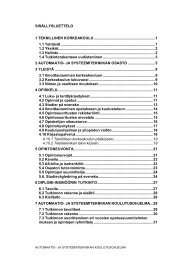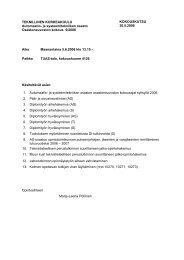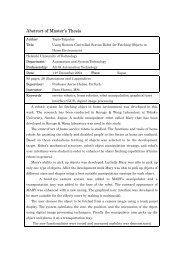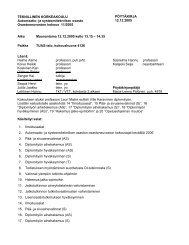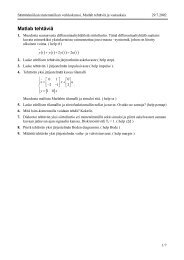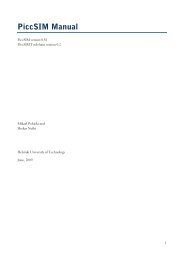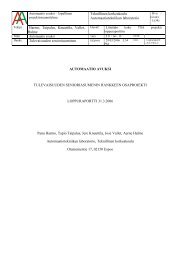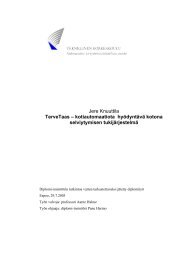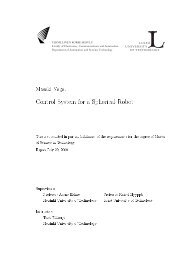fem modelling of a bellows and a bellows- based micromanipulator
fem modelling of a bellows and a bellows- based micromanipulator
fem modelling of a bellows and a bellows- based micromanipulator
You also want an ePaper? Increase the reach of your titles
YUMPU automatically turns print PDFs into web optimized ePapers that Google loves.
FEM <strong>modelling</strong> <strong>of</strong> a <strong>bellows</strong> <strong>and</strong> a <strong>bellows</strong>-<strong>based</strong> <strong>micromanipulator</strong>III. Modellingstrain concentration at those nodes. Even substantial strain-gaps would appear between somenodes, so that the result would then be less accurate, or maybe wrong. Hence, to avoid theseproblems <strong>and</strong> to make the aspect ratio <strong>of</strong> the elements close to 1, meshing has to be very fine.As shown in next figure, the number <strong>of</strong> elements will become enormous.(a)(b)Figure 13Mesh (a) is too coarse <strong>and</strong> couldinduce errors. So the mathematicalmodel should be more accurate,corresponding to the mesh (b).3.1.4 CHOOSING RIGHT SHELL 3D-ELEMENTBecause <strong>of</strong> the thin walls, this <strong>bellows</strong> should properly be classed as a shell <strong>of</strong> revolution forstress <strong>and</strong> displacement analyse purpose. The geometry <strong>of</strong> a shell is defined by its thickness<strong>and</strong> its midsurface, which is a curved surface in space. Load is carried by a combination <strong>of</strong>membrane action <strong>and</strong> bending action. A thin shell can be very strong if membrane actiondominates, in the same way that a wire can carry great load in tension but only small load inbending. A shell <strong>of</strong> a given shape can carry a variety <strong>of</strong> distributed loadings by membraneaction alone.However, no shell is completely free <strong>of</strong> bending stresses. They appear at or near point loads,line loads, reinforcements, junctures, changes <strong>of</strong> curvature <strong>and</strong> supports. In short, anyconcentration <strong>of</strong> load or geometric discontinuity can be expected to produce bending stresses,<strong>of</strong>ten much larger than membrane stresses, but usually quite localised in a “boundary layer”near the load or discontinuity.Flexure stress <strong>and</strong> bending moment in a shell are related in the same way as for a plate:t / 2Mx= ∫σ x⋅ z ⋅ dz ,y= ∫−t/ 2t / 2M σy⋅ z ⋅ dz , Mxy= ∫τ xy⋅ z ⋅ dz(3.3)−t/ 2where t is the given thickness <strong>of</strong> the shell element.A quadrilateral shell element can be produced by combining quadrilateral plane <strong>and</strong> plateelement. A four-node “flat” quadrilateral is in general a warped element because its nodes arenot all coplanar. A modest amount <strong>of</strong> warping can seriously degrade the performance <strong>of</strong> anelement. Commercial s<strong>of</strong>tware may allow only a very small amount <strong>of</strong> deformations.Curved elements <strong>based</strong> on shell theory avoid some shortcomings <strong>of</strong> flat elements, butintroduce other difficulties. More data are needed to describe the geometry <strong>of</strong> a curvedelement. Formulation is complicated, as it invokes a shell theory – <strong>of</strong> which there are many.Membrane <strong>and</strong> bending actions are coupled within the element, so it is harder to avoidmembrane locking, that is, harder to avoid great overstiffness in bending because details <strong>of</strong>the element formulation cause membrane strains to appear in association with bending action,<strong>and</strong> membrane stiffness is far greater than bending stiffness if the shell is thin.t / 2−t/ 2±I®L−¬°JXK¯ZYFigure 14Explanation picture <strong>of</strong> the SHELL43 element. It ismade <strong>of</strong> four nodes, I, J, K <strong>and</strong> L, <strong>and</strong> six differentfaces. Each <strong>of</strong> these surfaces can admit loads. At eachnode a different thickness t can be defined. Thiselement has plasticity, creep, stress stiffening, largedeflection <strong>and</strong> strain capabilities.15



